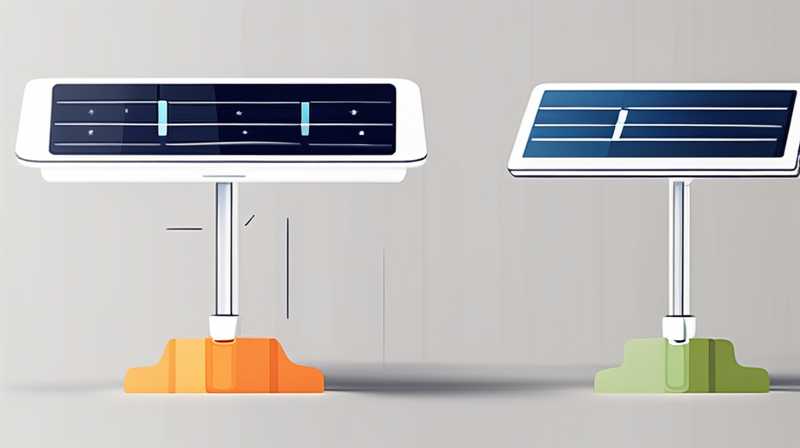
To effectively set the parameters of solar lights, one must consider several critical factors. 1. Determine the location; 2. Assess the amount of sunlight; 3. Choose the right features; 4. Adjust settings for optimal performance. Each of these elements plays a significant role in the functionality, efficiency, and overall utility of solar lights.
- DETERMINE THE LOCATION
The initial step in configuring solar lights involves identifying the appropriate placement. Solar lights function by relying on sunlight for power, meaning their efficiency is directly impacted by positioning. One should consider areas that receive maximum sunlight exposure, ideally for six to eight hours a day. On properties with obstructions such as trees or buildings, locating the lights in open spaces will enhance their operational capacity.
The type of surface where the solar lights are installed also contributes to their performance. For instance, placing lights on reflective surfaces can maximize the amount of light captured. Furthermore, understanding local climate conditions is essential. In regions prone to extended cloudy periods or heavy precipitation, solar lights may require alternative configurations such as supplementary charging solutions or higher-capacity batteries to maintain functionality.
- ASSESS THE AMOUNT OF SUNLIGHT
After determining the location, the next critical aspect involves evaluating sunlight availability throughout the year. Various factors can influence the amount of sunlight a specific area receives, including seasonal variations, local weather patterns, and the surrounding environment. Observing the area during different times of the day and year will provide vital information about potential sunlight exposure.
Conducting a shading analysis can prove helpful as well. Identify nearby structures and vegetation that might cast shadows during peak sunlight hours. You can also install solar lights temporarily to monitor their performance over several days. This assessment enables one to choose optimized solar lights designed to harness maximum sunlight, ensuring sufficient energy storage and usability.
- CHOOSE THE RIGHT FEATURES
Selecting solar lights equipped with the most fitting features is essential for optimizing their performance. Various models offer unique functionalities such as motion sensors, adjustable brightness settings, and customizable timers. Such features not only enhance energy efficiency but also improve the overall effectiveness of the lighting system.
When selecting features, one should consider the intended use of the solar lights. For example, motion sensors are suitable for security applications, as they illuminate the area only when movement is detected. Additionally, customizable brightness levels contribute to energy savings while catering to specific lighting requirements. By thoroughly evaluating which features align with one’s needs, one can ensure maximum satisfaction and reduced energy waste in solar light performance.
- ADJUST SETTINGS FOR OPTIMAL PERFORMANCE
Once the solar lights are installed and equipped with the necessary features, it is vital to fine-tune their settings. Many solar lights include adjustable parameters that allow users to control brightness, timing, and sensitivity of the sensors. Regularly reviewing these settings based on seasonal changes will enable one to optimize performance.
For instance, during longer daylight periods in summer, one may wish to reduce brightness levels to extend battery life. Conversely, during the shorter days of winter, increasing brightness may be necessary to ensure adequate illumination. Additionally, one must regularly check the lights for obstructions, ensuring nothing interferes with their capacity to absorb sunlight. Properly adjusting settings fosters efficient energy use, promoting a sustainable way to maintain illumination while minimizing environmental impact.
FAQs
HOW DO SOLAR LIGHTS WORK?
Solar lights operate using photovoltaic cells that convert sunlight into electrical energy. These cells charge an internal battery during the day, allowing the lights to illuminate once the sun sets. The efficiency of this process can vary based on light exposure and the quality of the components used. Most solar lights include a built-in sensor that detects darkness, automatically activating the light at dusk and turning it off at dawn. Proper placement and maintenance are vital for ensuring these solar lights function effectively.
WHAT FACTORS AFFECT THE PERFORMANCE OF SOLAR LIGHTS?
Several environmental factors can influence the performance of solar lights, including location, sunlight availability, and weather conditions. Areas that receive ample sunlight will ensure that solar lights operate optimally, while shaded or obstructed locations may reduce their effectiveness. Furthermore, seasonal changes impact sunlight intensity, so understanding these variables helps determine the best placement and settings for your solar lights. Regular maintenance and checking for dirt buildup on solar panels can also enhance their performance.
ARE SOLAR LIGHTS WORTH THE INVESTMENT?
Investing in solar lights can be worthwhile for multiple reasons. They provide a sustainable and cost-effective lighting solution without requiring electricity from the grid. The initial purchasing price is often offset by the long-term savings on electricity bills. Furthermore, solar lights come in various styles, making them suitable for both decorative and functional purposes. Their versatility and environmental benefits make them an appealing option for many property owners aiming to enhance outdoor lighting while promoting sustainability.
The value of properly setting solar lights extends beyond mere functionality; it encompasses environmental responsibility and cost efficiency. An educated approach to installation, maintenance, and settings ensures one’s investment pays dividends in the long term. By adhering to recommended practices, individuals can optimize their solar lighting systems for the best performance possible, which includes taking care to follow manufacturer guidelines while also tailoring solutions to specific use cases. Moreover, as technology advances, the options available for solar lights increase, providing consumers with more choices and innovative features that can deliver even greater impact. To fully harness the potential of solar lights, continuous adaptation and learning about new models, settings, and enhancements in this ever-evolving field will keep users informed and capable of making the most of their solar lighting experience. This proactive approach also leads to full realization of the benefits solar lights can provide, ensuring a well-lit, sustainable, and energy-efficient outdoor space that meets diverse needs while promoting greener living practices.
Original article by NenPower, If reposted, please credit the source: https://nenpower.com/blog/how-to-set-the-parameters-of-solar-lights/


